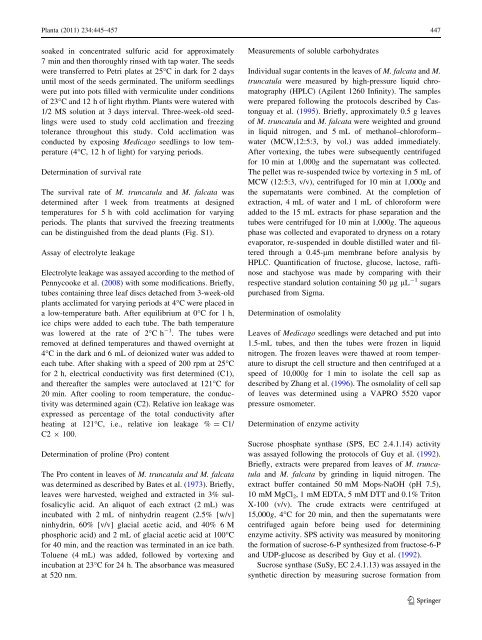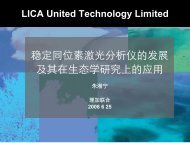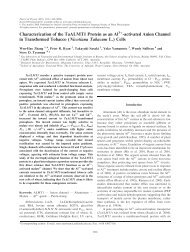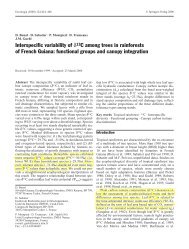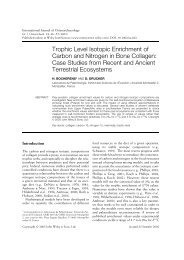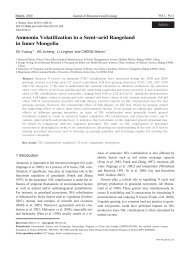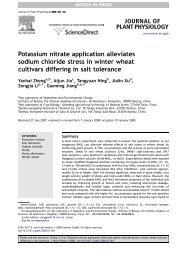Comparative studies on tolerance of Medicago truncatula and ...
Comparative studies on tolerance of Medicago truncatula and ...
Comparative studies on tolerance of Medicago truncatula and ...
Create successful ePaper yourself
Turn your PDF publications into a flip-book with our unique Google optimized e-Paper software.
Planta (2011) 234:445–457 447soaked in c<strong>on</strong>centrated sulfuric acid for approximately7 min <strong>and</strong> then thoroughly rinsed with tap water. The seedswere transferred to Petri plates at 25°C in dark for 2 daysuntil most <strong>of</strong> the seeds germinated. The uniform seedlingswere put into pots filled with vermiculite under c<strong>on</strong>diti<strong>on</strong>s<strong>of</strong> 23°C <strong>and</strong> 12 h <strong>of</strong> light rhythm. Plants were watered with1/2 MS soluti<strong>on</strong> at 3 days interval. Three-week-old seedlingswere used to study cold acclimati<strong>on</strong> <strong>and</strong> freezing<strong>tolerance</strong> throughout this study. Cold acclimati<strong>on</strong> wasc<strong>on</strong>ducted by exposing <strong>Medicago</strong> seedlings to low temperature(4°C, 12 h <strong>of</strong> light) for varying periods.Determinati<strong>on</strong> <strong>of</strong> survival rateThe survival rate <strong>of</strong> M. <strong>truncatula</strong> <strong>and</strong> M. falcata wasdetermined after 1 week from treatments at designedtemperatures for 5 h with cold acclimati<strong>on</strong> for varyingperiods. The plants that survived the freezing treatmentscan be distinguished from the dead plants (Fig. S1).Assay <strong>of</strong> electrolyte leakageElectrolyte leakage was assayed according to the method <strong>of</strong>Pennycooke et al. (2008) with some modificati<strong>on</strong>s. Briefly,tubes c<strong>on</strong>taining three leaf discs detached from 3-week-oldplants acclimated for varying periods at 4°C were placed ina low-temperature bath. After equilibrium at 0°C for 1 h,ice chips were added to each tube. The bath temperaturewas lowered at the rate <strong>of</strong> 2°C h -1 . The tubes wereremoved at defined temperatures <strong>and</strong> thawed overnight at4°C in the dark <strong>and</strong> 6 mL <strong>of</strong> dei<strong>on</strong>ized water was added toeach tube. After shaking with a speed <strong>of</strong> 200 rpm at 25°Cfor 2 h, electrical c<strong>on</strong>ductivity was first determined (C1),<strong>and</strong> thereafter the samples were autoclaved at 121°C for20 min. After cooling to room temperature, the c<strong>on</strong>ductivitywas determined again (C2). Relative i<strong>on</strong> leakage wasexpressed as percentage <strong>of</strong> the total c<strong>on</strong>ductivity afterheating at 121°C, i.e., relative i<strong>on</strong> leakage % = C1/C2 9 100.Determinati<strong>on</strong> <strong>of</strong> proline (Pro) c<strong>on</strong>tentThe Pro c<strong>on</strong>tent in leaves <strong>of</strong> M. <strong>truncatula</strong> <strong>and</strong> M. falcatawas determined as described by Bates et al. (1973). Briefly,leaves were harvested, weighed <strong>and</strong> extracted in 3% sulfosalicylicacid. An aliquot <strong>of</strong> each extract (2 mL) wasincubated with 2 mL <strong>of</strong> ninhydrin reagent (2.5% [w/v]ninhydrin, 60% [v/v] glacial acetic acid, <strong>and</strong> 40% 6 Mphosphoric acid) <strong>and</strong> 2 mL <strong>of</strong> glacial acetic acid at 100°Cfor 40 min, <strong>and</strong> the reacti<strong>on</strong> was terminated in an ice bath.Toluene (4 mL) was added, followed by vortexing <strong>and</strong>incubati<strong>on</strong> at 23°C for 24 h. The absorbance was measuredat 520 nm.Measurements <strong>of</strong> soluble carbohydratesIndividual sugar c<strong>on</strong>tents in the leaves <strong>of</strong> M. falcata <strong>and</strong> M.<strong>truncatula</strong> were measured by high-pressure liquid chromatography(HPLC) (Agilent 1260 Infinity). The sampleswere prepared following the protocols described by Cast<strong>on</strong>guayet al. (1995). Briefly, approximately 0.5 g leaves<strong>of</strong> M. <strong>truncatula</strong> <strong>and</strong> M. falcata were weighted <strong>and</strong> groundin liquid nitrogen, <strong>and</strong> 5 mL <strong>of</strong> methanol–chlor<strong>of</strong>orm–water (MCW,12:5:3, by vol.) was added immediately.After vortexing, the tubes were subsequently centrifugedfor 10 min at 1,000g <strong>and</strong> the supernatant was collected.The pellet was re-suspended twice by vortexing in 5 mL <strong>of</strong>MCW (12:5:3, v/v), centrifuged for 10 min at 1,000g <strong>and</strong>the supernatants were combined. At the completi<strong>on</strong> <strong>of</strong>extracti<strong>on</strong>, 4 mL <strong>of</strong> water <strong>and</strong> 1 mL <strong>of</strong> chlor<strong>of</strong>orm wereadded to the 15 mL extracts for phase separati<strong>on</strong> <strong>and</strong> thetubes were centrifuged for 10 min at 1,000g. The aqueousphase was collected <strong>and</strong> evaporated to dryness <strong>on</strong> a rotaryevaporator, re-suspended in double distilled water <strong>and</strong> filteredthrough a 0.45-lm membrane before analysis byHPLC. Quantificati<strong>on</strong> <strong>of</strong> fructose, glucose, lactose, raffinose<strong>and</strong> stachyose was made by comparing with theirrespective st<strong>and</strong>ard soluti<strong>on</strong> c<strong>on</strong>taining 50 lg lL -1 sugarspurchased from Sigma.Determinati<strong>on</strong> <strong>of</strong> osmolalityLeaves <strong>of</strong> <strong>Medicago</strong> seedlings were detached <strong>and</strong> put into1.5-mL tubes, <strong>and</strong> then the tubes were frozen in liquidnitrogen. The frozen leaves were thawed at room temperatureto disrupt the cell structure <strong>and</strong> then centrifuged at aspeed <strong>of</strong> 10,000g for 1 min to isolate the cell sap asdescribed by Zhang et al. (1996). The osmolality <strong>of</strong> cell sap<strong>of</strong> leaves was determined using a VAPRO 5520 vaporpressure osmometer.Determinati<strong>on</strong> <strong>of</strong> enzyme activitySucrose phosphate synthase (SPS, EC 2.4.1.14) activitywas assayed following the protocols <strong>of</strong> Guy et al. (1992).Briefly, extracts were prepared from leaves <strong>of</strong> M. <strong>truncatula</strong><strong>and</strong> M. falcata by grinding in liquid nitrogen. Theextract buffer c<strong>on</strong>tained 50 mM Mops-NaOH (pH 7.5),10 mM MgCl 2 , 1 mM EDTA, 5 mM DTT <strong>and</strong> 0.1% Trit<strong>on</strong>X-100 (v/v). The crude extracts were centrifuged at15,000g, 4°C for 20 min, <strong>and</strong> then the supernatants werecentrifuged again before being used for determiningenzyme activity. SPS activity was measured by m<strong>on</strong>itoringthe formati<strong>on</strong> <strong>of</strong> sucrose-6-P synthesized from fructose-6-P<strong>and</strong> UDP-glucose as described by Guy et al. (1992).Sucrose synthase (SuSy, EC 2.4.1.13) was assayed in thesynthetic directi<strong>on</strong> by measuring sucrose formati<strong>on</strong> from123


